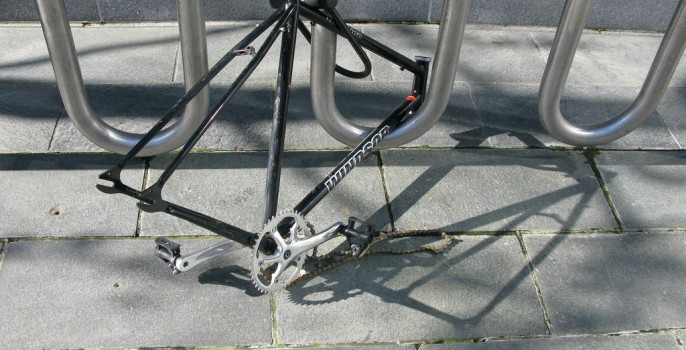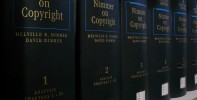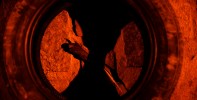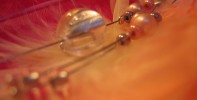Kathy Jeffords of The Dreamy Giraffe is the epitome of a self-made Etsy tycoon. She abruptly quit her job just before her niece was born and sold ACEOs on eBay on a whim before searching for a new job. The job search was put off by a month, then another month – now her niece is nearly eight years old and Kathy’s resume still sits on a disk somewhere collecting dust.
As Kathy’s art gained in popularity, so too did the difficulty of dealing with the art being stolen, unwittingly or otherwise, on the internet. Her tale of copyright infringement, DMCA notices and struggling with the ups and downs of social media serves as a cautionary tale for any Etsy seller.
“I hate to be the bearer of bad news, but I’ve found someone using your art.”
Those are words you never want to read in an email. My stomach dips as I pull up the site and see my artwork – uncredited, sometimes for sale. It happens too often. When I see my art stolen, my hands start to shake. I can feel my blood pressure going up. The emotional response is just as strong every time.
The internet was a different place when I first started selling my art. MySpace was the extent of social media, Etsy was just a baby. I was barely used to being an artist; the thought of being an artist who actually sold work blew my mind. I remember looking at an Etsy shop with 500 sales and thinking “I’ll never, ever sell that much!”
In those early days, I never imagined that my images would find their way out of my Etsy shop.
I never expected to be staring dumbfounded at a DeviantArt page filled with images of my art – paintings that took days to create, little pieces of my heart and soul. This particular thief had the audacity to not only to claim my art as their own, but also perpetuate the lie by telling stories about how they were inspired to paint each piece.
I filed my first DMCA notice with plenty of proof that the art was mine. DeviantArt swiftly removed the images, and I learned a valuable lesson – always, always keep work-in-progress shots that you don’t share with anyone. This is the best defense if you need to prove that your art is indeed your own.
Last year, I found a Facebook page from Croatia selling jewelry with my artwork on it. I posted alongside a handful of other Etsy sellers, identifying my work and asking her to remove it. She blocked her page from everyone outside Croatia and told her fans we were lying, that she had permission to use the images. Even if she’d asked permission and agreed to pay me royalties for using my work, I never would’ve approved the jewelry – it just wasn’t a good fit for my brand.
Since then, I’ve started putting copyright info at the bottom of my images. I know it won’t stop thieves with truly malicious intent. I’d have to put a big, obtrusive watermark across my girl’s faces to prevent the determined. I don’t want to ruin the experience of looking at my work for everyone because of a few bad apples.
Social media is now far beyond MySpace. Twitter, Tumblr, Facebook, Pinterest – they can all be beneficial to artists and the bane of our existence. It’s so easy to hit a button and share something you like without a thought to where it came from or who owns it. Someone created that image. Someone owns the copyright to it. If you use it without permission, without any kind of credit or link, you’re infringing. Someone’s blood pressure is rising.
I used to enjoy Pinterest; now every time I browse the site, I stumble upon one of my images. Images not linked to my Etsy shop, but some random Tumblr or blog. It’s disheartening, to say the least.
I was a writer long before I was an artist – I use my original writing in my art a lot. Many people don’t understand that words are copyrighted too. So many of the typography prints on Etsy are infringing on copyright. Song lyrics are copyrighted. Poetry is copyrighted.
It’s so hurtful to have my original writing taken and used for profit. I’ve Googled words from some of my prints and found them in quite a few places, attributed to “anonymous” or “unknown.” I’ve found prints on Etsy using my words, recycled through unattributed Pinterest pins, now competing with my own work for sales. It’s tougher to prove ownership of words than it is for images.
It’s painstaking to file DMCA notices. It’s time consuming; I’d rather spend the time creating. The alternative is asking people nicely to stop using your work. The results are mixed – often the thief is belligerent and nasty. One person admitted my poem wasn’t their original creation, but refused to stop using it since I couldn’t prove that it was mine.
Many people misunderstand copyright and don’t believe they’re doing anything wrong until someone officially tells them to stop. Many people think the results on Google Images are free for the taking. That’s not how it works. If you didn’t create it, you can’t use it without permission.
It’s so easy to infringe copyright on the internet; most of us have done it at one time or another, quite innocently without ill intent. It’s our natural urge to share the things we like. It takes work to be more thoughtful, to pause and consider where something originated to at least give credit where it’s due. Sometimes there’s no trail back to the artist and only Google Search by Image can lead you back to the original.
I encourage everyone to take the effort. Pause and imagine how you’d feel if those were your images or words being used without your permission. Don’t assume that it’s okay just because everyone else is doing it.
Remember to add copyright info to your images – and please, keep sending me those emails when you see my images out in the wild. I’d rather have high blood pressure than not know about it.
Get my latest articles straight to your inbox about once a month. Learn how to improve your Etsy shop, boost your sales and discover other sellers from the Etsy community.







